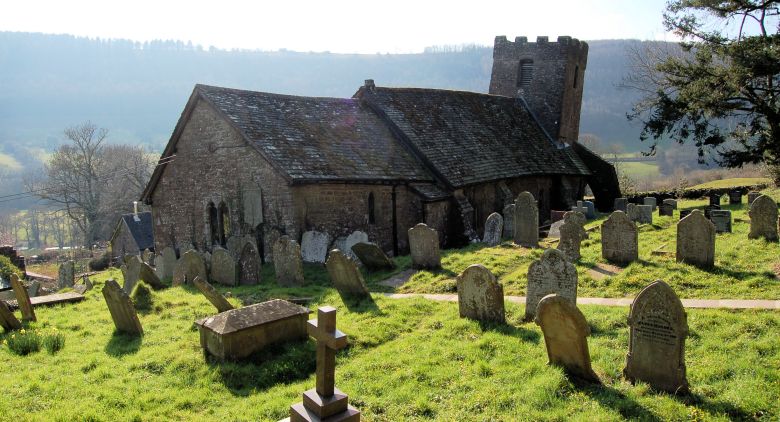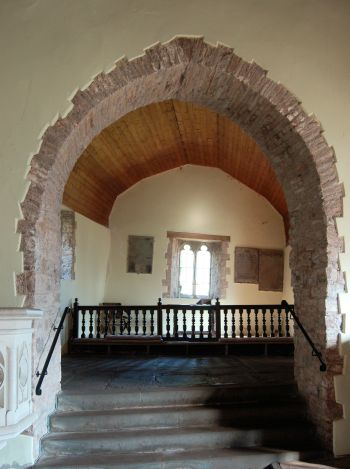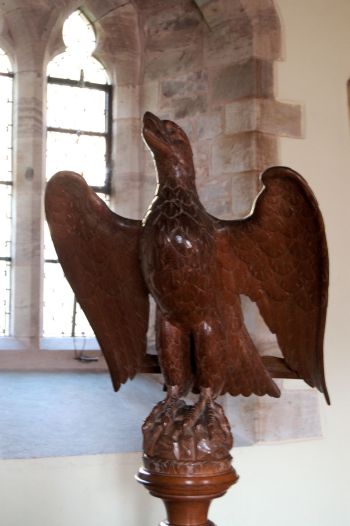St Martin's Church, Cwmyoy (Cwmiau), Monmouthshire Denomination: Anglican
Denomination: AnglicanDedication: St Martin of Tours Built: Medieval Restored: 1887 and 1991 Photography: John Ball Date: 16 March 2016 Camera: Nikon D50 digital SLR A long delayed photographic expedition to the old parish church at Cwmyoy in the Vale of Ewyas. Despite (or maybe because of) its querkiness, the church is obviously very much cherished and tended by its parishioners. [JLB 2016]
Note 1: Soon after turning into the [Llanthony] valley you will descry amid the heights ahead a weird, bulbous summit. That is the Cwmyoy landslide, a mighty fragment torn away from the Hatterall ridge. Seen from afar, the landslide seems like an immense boil on the shoulder of the Hatterall. The chancel of Cwmyoy church is a remarkable example of a "weeping chancel". In many of our churches, the axis of the chancel is out of line with the axis of the nave, for the nave represents our Lord's body, and the deflected chancel His head fallen sideways in death. At Cwmyoy, not only the axis but the whole chancel slews sideways, and it seems that the builders planned it thus , for if the slant had been due to the landslide it should have followed the slant of the tower. There is little change since 1682, when Tom Price was buried there.


Church Exterior and its chancel to the south. The building to the left is the old vicarage. 
Note 2: The church is an ancient building, and is remarkable in that in no one part of it is it square or at right angles with any other part. The building looks as though its foundations had all been moved by an earthquake or landslip. [Source: A History of Monmouthshire: Part II The Hundred of Abergavenny by Joseph Alfred Bradney, Mitchell Hughes and Clarke, London, 1906]  Above: St Martin's Church, viewed from the southeast. Three flying buttresses support the nave and chancel. Below: St Martin's Church, viewed from the northeast. At the northwest corner, a massive flying buttress supports the tower.  Note 3: The church lies on a shelf above the Honddu, so affected by landslips that the walls now lean at a variety of crazy angles. Even with the support of huge flying buttresses it is difficult to see how the west tower remains standing. [Source: The Old Parish Churches of Gwent, Glamorgan & Gower by Mike Salter, Folly Publications, Malvern, 1991; ISBN 1-871731-08-9] 

Note 5: St Martin's Church, Cwmyoy is constructed in local fine grained red/grey sandstone coursed rubble, with stone tiled roofs which were renewed in 1887. The walling is medieval with considerable repairs and rebuilding as a result of ground instability. The church consists of nave, chancel, south porch and west tower with external stair turret and castellated parapet. The church is heavily buttressed, with three stepped ones to each side of the nave and one to the south wall of the chancel, and large flying buttresses to the tower, these are all Victorian additions. The nave has three windows in either wall, three identical two-light Decorated ones which are Victorian; the north west one which is 12th-13th century; the south east one which is 13th-14th century; and the three-light middle window of the south wall which is probably 16th century. The chancel appears to have been built separately from the nave. It has a small pointed window on either flank wall and a two-light east window with cusped heads, this may be 14th century. The tower is medieval, it is twisted and leans at a considerable angle towards the south west. There are a number of painted tombstones and a stone cross carved with an unusual image of Christ, thought to date from the 1200s. [Source: Coflein database of the Royal Commission on the Ancient and Historical Monuments of Wales (accessed 17 Mar 2016)] South porch

Right and Below: Examples of several decorated plaques on the walls of the porch and on each side of the entrance to the nave. 
Church interior 

Right: Steps leading up from the nave into the chancel, 



 Right: Eagle lecturn. 
 Right: Plaque commem-orating the deaths in 1788 and 1790 of Mary, aged 8, and Mary aged 14 weeks, daughters of Mr. Williams of the Sharpal. Left: Medieval cross showing the figure of Christ. The design is unusual for the mitre with three crosses on the head of Christ.
 Left: 17th century commemorative slab on floor of chancel.
Left: 17th century commemorative slab on floor of chancel.
HERE LIETH 
In Memory of William Watkin Who Died April ye 21st 1748 Aged 73 
Right: Ancient churchyard cross.
|
 Note 4: The church has suffered appreciably from local subsidence. The main reason is that the charch was built immediately below the site of a spectacular landslide, which occurred towards the end of the Quaternary Ice Age [about 12,000 years ago].
Note 4: The church has suffered appreciably from local subsidence. The main reason is that the charch was built immediately below the site of a spectacular landslide, which occurred towards the end of the Quaternary Ice Age [about 12,000 years ago].